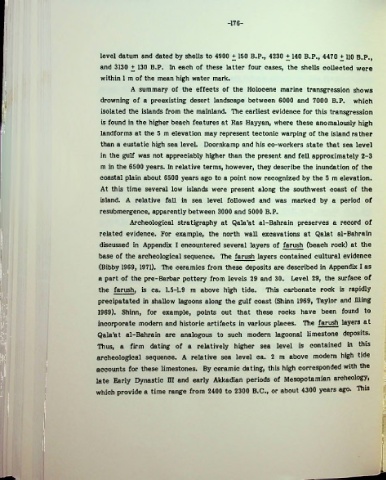Page 200 - Life & Land Use on the Bahrain Islands (Curtis E Larsen)
P. 200
-176-
level datum and dated by shells to 4900 + 150 B.P., 4230 + 140 B.P., 4470 +110 B.P.,
and 3130 + 130 B.P. In each of these latter four cases, the shells collected were
within 1 m of the mean high water mark.
A summary of the effects of the Holocene marine transgression shows
drowning of a preexisting desert landscape between 6000 and 7000 B.P. which
isolated the islands from the mainland. The earliest evidence for this transgression
is found in the higher beach features at Ras Hayyan, where these anomalously high
landforms at the 5 m elevation may represent tectonic warping of the island rather
than a eustatic high sea level. Doornkamp and his co-workers state that sea level
in the gulf was not appreciably higher than the present and fell approximately 2-3
m in the 6500 years. In relative terms, however, they describe the inundation of the
coastal plain about 6500 years ago to a point now recognized by the 5 m elevation.
At this time several low islands were present along the southwest coast of the
island. A relative fall in sea level followed and was marked by a period of
resubmergence, apparently between 3000 and 5000 B.P.
Archeological stratigraphy at Qala’at al-Bahrain preserves a record of
related evidence. For example, the north wall excavations at Qalat al-Bahrain
discussed in Appendix I encountered several layers of farush (beach rock) at the
base of the archeological sequence. The farush layers contained cultural evidence
(Bibby 1969, 1971). The ceramics from these deposits are described in Appendix I as
a part of the pre-Barbar pottery from levels 29 and 30. Level 29, the surface of
the farush, is ca. 1.5-1.9 m above high tide. This carbonate rock is rapidly
precipatated in shallow lagoons along the gulf coast (Shinn 1969, Taylor and Illing
1969). Shinn, for example, points out that these rocks have been found to
incorporate modern and historic artifacts in various places. TTie farush layers at
Qalafat al-Bahrain are analogous to such modern lagoonal limestone deposits.
Ttius, a firm dating of a relatively higher sea level is contained in this
archeological sequence. A relative sea level ca. 2 m above modern high tide
accounts for these limestones. By ceramic dating, this high corresponded with the
late Early Dynastic HI and early Akkadian periods of Mesopotamian archeology,
Tli is
which provide a time range from 2400 to 2300 B.C., or about 4300 years ago.

